THE BEGINNINGS OF ADVENTURE
My sense of Geography and adventure has been apparent from an early age. As soon as I could ride a bicycle, I always went further than I was ever permitted to do so. I loved to explore, and I became a keen cyclist in the process. I always found the excitement of adventure completely intoxicating, it takes over, but it can sometimes cause a lot of trouble…. like on a school art trip aged 11to the Tate Gallery in London when I decided to leave the gallery on my own and explore the Embankment of the Thames and the City. Like the time when I was 10 and put out to sea from Blyth Beach in an inflatable dinghy with my friend Graeme Moss (strictly forbidden by my parents as I could not swim for one thing) …. then we caught a rare Opah (or Moonfish) which got us in the national newspapers, on national TV, and it caused chaos in our town as the local fisherman fought to own the rights to the fish, and more importantly, the glory of landing one of the rarest ever catches in UK waters. Yes, you never know where an adventure might lead! Shortly after this adventure, in 1981, something came along that completely captivated me and took my breath away ……Steven Spielberg’s blockbuster movie ‘Raiders of The Lost Ark’. Wow! This is exactly what I craved in my life; history, secrets, artefacts, people, and adventure.I was a dreamer and I wanted to be Indiana Jones. Period. I was sold!
BACKGROUND
You have probably now deduced that I grew up in the small coastal town of Blyth which is in the English County of Northumberland close to the great North East city of Newcastle-upon-Tyne in the United Kingdom. A small city with a big reputation,Newcastle and the North-East of England is famed not only for wonderfully friendly no-nonsense people, but also for pioneering engineering, ship-building and coal-mining. Indeed, the natural resource that lay deep beneath the ground of the Northumberland and Durham coalfields was to play a significant role in the The Industrial Revolution that would rapidly change the very world that we live in. The Newcastle area has a world leading industrial heritage and a number of engineering ‘firsts’ to it’s name, including but not limited to; Stephenson’s Rocket 1829 (the World’s first true steam-engined hauling locomotive); Turbinia 1894 (the World’s first steam-turbine powered ship and thus the World’s fastest ship at the time); The Hydraulic Lifting Crane 1846 (Armstrong) ….. all of these incredible engineering inventions came from the banks of the River Tyne.
With such a foundation, it is of little surprise that the people of the North East have an incredible passion for engineering, and this is no better reflected than in the local passion for cars and motorcycles. Throughout my childhood and teenage years, I worked hard at school but I was equally keen to work alongside my Father George who has always been synonymous in the old car and motorcycle world of the North East. Being a relatively small city (pop approx. 300,000) I got to know many of the big characters from the local scene and over time I heard all the motoring stories and local legends too. Stories of amazing cars from long ago fascinated me. Dad had always been an adventurer too, and had many great stories to tell about his own motoring escapades, so we can safely say that he enticed me down this road of automobile archaeology and adventure!
A LEGEND
One legend that continually fascinated me as a young man was that of an exotic late 1930’s sports car that had been seen in the local area in the immediate post World War II period.The Nazi’s had not long since bombed Blyth attempting to scupper it’s huge industry and economy fuelling coal shipments, it’s renown ship-building, and it’s submarine-base activity.At this time the town was a bruised and impoverished area where food-rationing was mandated, so no fancy motor-car ownership would have gone un-noticed. It’s important to also appreciate that England at this time, early post-war, was still predominantly a motor-cycling nation and car ownership was beyond the reach of most working-class people. As a young man intrigued by motor-cars, my Dad had stolen a glance of this mysterious car in the early 1950’s and was instantly mesmerised not only by its distinctive sound, but by its speed, and its long low-bodied elegance and coupe styling. The car was very rarely seen but was rumoured to be associated with Blagdon Hall, the seat of Viscount Lord Ridley just 3 miles upstream along the River Blyth from our family home. Amongst the local mining communities of South East Northumberland, this car was of course, the stuff of legends, but had only been sighted a couple of times. Some people said there had been an old racing Bentley up at the Hall, some thought a special-bodied Rolls-Royce. Dad’s instinct had always told him it was something way more special, something distinctly more exotic.I was completely fascinated by this tale of local motoring legend, but I often wondered just how ‘tall’ of a tale it really was!
RUMOURS
A generation later in the mid-1980’s, l myself am a car obsessed teenager. I’m increasingly immersed in my Dad’s world of classic engineering, sales and restoration and I’m hanging on the words of every old car story I hear about Newcastle and the surrounding area. Stories of old kept alive by local enthusiasts intrigued me, particularly those of motoring exotica rumoured to have once been in the local area….. Lagonda, Delahaye, Frazer-Nash, Buick, Hispano-Suiza,Bentley, Delage, Packard, Bugatti, Cadillac, Duesenberg ……some of the world’s most iconic makes of cars, often kept me awake at night. The thought of real 1930’s auto-exotica having existed on our very own doorstep was absolutely mind-blowing to me. Could it be possible that any of these cars actually existed here? In this small North-Eastern city? So far from London? So far from the glamour of New York or Paris? The odds I thought, were pretty remote. Regardless, I was intrigued and fascinated in equal measure. Having said that, I’d witnessed with my own eyes the deep-rooted passion that cars and engineering can stir in people here. So maybe. Just maybe, the characterful people of the North East of England could be harbouring another incredible history, a history just waiting to be discovered?
ARCHAELOGICAL RESEARCH
I have always found History a fascinating subject and my studies at school as a teenager had increasingly taken a humanities route. (In-time I would also become a Humanities Teacher). To understand history, we need to study accounts of human experience and thus I’ve always had a great deal of time and respect for older generations. Hearing people talk about their life experiences, their passions and their knowledge can be so profound in trying to understand the past ….and can possibly be the master-key to unlock secrets of the past. People intrigue me and I’ve always been conscious that so much knowledge and memories are lost in the sands of time if they are not passed-down or documented. It’s a crazy thought that it has taken the work of explorers and archaeologists to ‘re-discover’ significant human events and human achievements that have simply been lost and forgotten by the human race…. take the incredible abandoned and forgotten Mayan cities of Chetzen-Itza and Coba; the incredible skills and achievements of the ancient Aztecs and Egyptians; …what happened? How had all this knowledge and history been forgotten?
So could rumours of a wartime Delahaye, a Bugatti, or a Buick Phaeton running around the streets of Blyth and Newcastle actually be true? Or could these simply be romantic tales of fiction, Chinese whispers or even just cases of mistaken identity?
Whist working hard during the day in my studies at school (yes I was a high achiever!) I was also getting an incredible education after hours and at the weekend. A very unorthodox education yes, but one of incredible colour, substance and value. My Dad had never really had any formal education, but during my teenage years he took me everywhere with him, so what I embraced was a Newcastle street education like no other person would ever get. Throughout this time, I had been secretly logging accounts and tales from the local auctions, pubs, from notorious local gangsters, back street garages, wealthy private collectors with hidden hoards, and successful businessmen with car obsessions alike. There was no part of the hard-core Newcastle business and car scene that I wasn’t exposed to and I have to say that I met some very colourful and intriguing people. Time spent in North East pubs was a significant part of my education, and one can never underestimate the wealth of historical accounts and hidden information I have absorbed from people in these places.
However, the very mention of a mysterious Bugatti sighting would send shivers down my spine and heighten my senses. As a young historian and already automobile obsessed teenager, I understood even back then the gravity of Bugatti as automotive artefacts. I had a number of model cars on the window-sill of my bedroom at home, but it was the blue 1937 Bugatti Atlantic that always bore the greatest mystique.Having read about the black 1937 Atlantic vin#57591 originally purchased by British Industrialist Robert B. Pope, I completely understood the lure of the Bugatti marque …..that particular car now belongs to Designer Ralph Lauren and is widely considered to be the most desirable motor car on the planet, and thus seemingly ‘priceless’. Over the last century, the finest of the worlds exotic automobiles have been purchased by a certain people on this small island of Britain, which was after all, the financial and naval HQ of a global Empire, and thus, had the wealth to buy the most luxurious and distinctive items crafted by man. Following the unveiling of Jean Bugatti’s concept prototype ‘Aerolithe’ at the Olympia London Motor show in 1935, the Bugatti factory in Molsheim (France)would undertake 2 orders for road-going ‘Atlantic’ models out of a total production run of 4 vehicles. This was to be one of the world’s most exquisite and capable road machines. Lord Rothschild and Robert B. Pope were to be the two British owners of Atlantics and Jean Bugatti would retain the 3rd for himself. For those not familiar with the marque, Bugatti represents not just an old car, but to this date, probably the world’s most intriguing super-car. The premier Bugatti models of the late 1930’s sported a super-charged inline 8-cylinder over-head valve and double overhead camshaft engine. This was effectively the 1930’s equivalent of a road-going Formula 1 car, but Bugatti also represented a motoring icon of art-deco styling, fashion and elegance; a motor-car that was as acceptable on the race track at Le Mans as it was outside the Royal Albert Hall in London for the evening opera. Bugatti in the 1930’s was, the artistic and mechanical crème de la crème of this human invention we call the sports motor-car.
THE QUEST
So, all things considered, was it really so far-fetched an idea that an exotic Bugatti could possibly have resided here in Newcastle? A city with an appreciation for engineering and the industrial success to pay for one?
I had hung on the words of any rumours regarding 30’s exotica. The Newcastle car fraternity of the 1960’s remembered seeing something very unusual in and around the city that had the look of a late 30’s road-going race car. Bugatti was a name mentioned, but the rumours were vague and differing. Bentley, Lagonda, Delahaye and Hispano Suiza were other names suggested, but what became apparent to me was that all these stories and sightings were probably of the same car. Could this have been the same car Dad had seen as a boy in the early 1950’s? The descriptions were of a low-bodied racing coupe, non-English in design/ likely European, large diameter spoked wire-wheels, and a sound that was more characteristic of an aero engine ….these were repeated common-denominator characteristics. The sightings had all been in a geographical area covering just a few square miles. The car was believed to have had a wealthy owner, some suggested the owner was eccentric, but the consensus was that the car would obviously now be long gone, probably wrecked and scrapped years ago and that the owner would have likely passed-on many years ago too. However, there was no doubt in my mind any longer…. a very exotic car had once existed here.
THE MASTER KEY
But the reality was that no-body actually knew for sure. There were no facts, there was no hard evidence for the existence of the mystery car, or its fate. These were just tales from decades ago, told by car-obsessed enthusiasts.The credibilityof information I sourcedwas difficult to ascertain, but what I heard from the Johnson Brothers, a second-generation family of Newcastle motorcycle engineers, one Saturday afternoon, literally made the hairs stand up on the back of my neck. Call it instinct, call it teenage hormonal-overload, excitement, or an Indiana Jones moment of realisation, I don’t know. But what I felt was a sudden connection to something that felt very real. A chord had been struck. Not a musical chord, but a chord that was running down my spine and giving me goosebumps.
The Johnsons ran their family Motorcycle business ‘Rite Bike’ from the motorcycling mecca that was Westgate Hill in central Newcastle. Every Saturday Dad and I would spend the day on the hill, browsing the multitude of motorcycle dealers and chatting with the 1000’s of bike enthusiasts that would congregate there. It was wild. Every make and model of bike you could imagine would appear there. Bikes would be high-speed wheelieing up and down the hill, weaving between cars, double-decker buses, teasing the Police. Screechingsirens were drowned out byroaring rounds of jeering and crowd applause from the enthusiast bikers who would be devouring the best fish and chips in the ‘Toon’from newspaper sheetwhilst watching the illegal two-wheeledcircusaction in front of them. But inside Rite Bike, we would be talking history and engineering. The serious stuff.These guys are good family friends and as straight as the day is long. Their deceasedfather Jerry, old school, successful and sharp, had been a good friend of Dad’s and he had knownof a guy in the Gosforth areaof the town, the part over-looking the Town Moor. It was believed he had a Delahaye or maybe a Bugatti. The Brothers remembered their Dad talk about it. Apparently, the guy was eccentric, unapproachable and paranoid. I listened and evaluated the tale. I knew a Delahaye would not have fallen into the category of a road-racer, but a Bugatti would. The Brothers themselves had never ever seen the car, met the owner, or had any idea what had happened to him or the car. It was a long time ago.But there was definitely an exotic European road-going race car that had resided near the Town Moor in the late 1950’s. The owner was rumoured to be a surgeon or ex-military surgeon during the war, but as time passed, both the story and the owner of the car had just faded away from the 1950’s. Nothing else was known, heard, or seen of said car,but one thing that’s for sure, if there was anything to know, the brotherswould have known about it. They were without doubt, the eyes and ears of the Newcastle motor-engineering world, and they had agood nose for treasure. Talking to brothers Jerry and Ray, my Dad believed that the mysterious owner of the mysterious car in question and the long-since passedMajor Barlow of Spittal Tongues (see The White Hand) would most likely have been connected…….both being local gentry, both possibly having servedin World War Two, both very privateindividuals/batchelor car enthusiasts, and significantly, bothliving within 1 mile of each other.An exotic car of this calibre would only be owned by someone from the upper echelons of society, and this is indeed a very small societal group in our local population.
My curiosity about this legendaryexotic 1930’s supercar in the local area was un-extinguishable and now my cataloguing of clouded rumours and misty old tales was complete. I was sure that the car existed, butnow I actually had a specific geographical area to target my investigations.As an enthusiastic Geography and History High School student in the 1980’s, here also lies the beginnings of my life in Automobile Archaeology. I was potentially on the scent of a very significant historical super-car, a quest that could turn out to be as ridiculous as it was hopeless. But in my mind, this was the quest of a lifetime. An intoxicating rush of adrenaline was telling me ……THE GAME IS ON !!
INDIANA JONES AND THE HUNT FOR THE LOST BUGATTI
Come late September, 1986, my archaeological investigation dramatically stepped up a gear when my provisional driving license arrived in the post. Just a few more weeks and I would have the freedom to drive! But more importantly, I had just acquired anew found freedom to explore the streets of Newcastle, adult free, like never before. More specifically, I would now have the resources and ability to comb my target area!
Upon reaching the permitted age to drive, one’s Father would normally take on the role of teaching his Son how to drive a car. However, my Dad had ticked that box many years ago when he began supervising me steering every car he bought, initially from his lap, when I was 18 months old. (I am deadly serious here, I cut my teeth in an ensemble of 60’s Jags, Buicks and Ford Galaxies!). So now, at age 17, I was already a pretty damn good driver just needing some traffic experience under my belt. Partly owing to the fact that Dad had just had his license confiscated (don’t ask!), my best friend Michael Welsh was designated the job of being my sit-in supervisor passenger. Wow! Me and Mick were thrilled! I could not have wished for a better result! So, unbeknown to my very trusting parents, whom I promised we would stay very local, each night after school, under the cover of darkness, we headed into the City of Newcastle-upon-Tyne, to explore it like never before. Now the game was really on!
Night after night, all through the Winter of 1986 we combed the residential streets of Gosforth and Jesmond. The common-sense part of my brain knew this was going to be a fruitless search but my adventurous side wasn’t listening and it just craved the excitement. I had narrowed down the search area to the wealthier part of town, the houses were big, they had garages and they had driveways. The more common terraced-house areas were too unlikely a place to expect ownership of a rare exotic car. Was I hoping to get a glimpse of a 1930’s Bugatti? Yes! Was I ridiculous? Yes! But I didn’t care, my mission was one of lust. My senses were heightened and the sense of adventure was exhilarating. My heart raced as we cruised the narrow streets, up and down, repeatedly, night after night, to the point where we expected someone would call the Police. All through October, November, December of 1986, in darkness, through snow, ice, rain and hail, not only did I learn to slide and drift a rear-wheel drive car, but I learned those city streets like the back of my hand. When I say car, I actually mean van. Not just any van, but unfortunately, the most conspicuous van you could ever imagine. Dad had bought an ex-local authority Bedford HA Viva van specifically for me get driving practice in, because it was cheap and it was economical. Obviously, he wasn’t going to trust me and Mick let loose with any fancy car, partly due to the fact that Mick had only just recently passed his own driving test! However, this van was city council regulation bright yellow. Oh dear, not ideal for a covert operation! Or was it? As we drove up and down the same streets’ night after night, listening to ‘The Pet Shop Boys’ album on repeat (globally successful 80’s pop duo also from Newcastle), no-one was suspicious of our snooping because they just dismissed us as workers for Newcastle City Council. Bingo! This is just the best cover I could ever have hoped for!It was also a bad Winter that year, so the Council would have had lots of maintenance issues with salt bins and street lamps so we went about our business pretty much un-noticed. There were few people on the cold, windswept and uninviting streets after dark, in what I refer to as the English ‘hibernation period’ on the run-up to Christmas, where everyone stays home saving money for the forthcoming festive season. Fortunately, I had another huge stroke of luck with the official search vehicle because it ran on a fuel-efficient Liquid Petroleum Gas conversion and I could buy this stuff so cheap, literally 2 quid would get me a few hundred miles each week out of my very meagre £5 pocket money. Result!
And there it was. As we slowly trundled up a silent snowy street one night. I drove right past before it registered in my brain. Jumping on the brakes in an un-prompted emergency stop, the old van slid sideways in the snow and bumped hard into a kerb. “What the hell?!!” Mick roared with laughter. But I am frozen serious and I’m not laughing. We are in an elegant residential street in Gosforth, on the north side of Newcastle. The posh part. The street is Westfield Grove. What I have seen is a rickety 6ft high timber fence. The high fence is out of place amongst the beautiful 1930’s Arts and Crafts style homes and manicured privet hedges in this beautiful residential street. It just doesn’t fit. There is an overgrown, straggling un-pruned mature tree hanging over it. This is not typical. The fence looks to have been roughly constructed by a very amateur joiner. Is this an abandoned plot or derelict house I ask myself? The plot doesn’t seem to belong to either of the private houses on each side. It looks like the fence has been constructed to screen something from public view. I got out of the van and walked up to the fence to take a closer look. “What are you doing?!” whispered an alarmed Mick. “you’re gonna get us arrested!” But I wasn’t answering. I was on a mission, totally focussed, and my senses are fully locked on to a target. There’s something here, I can sense it. Mick is getting pretty nervous now, because we are attracting attention. Some house lights have just turned on opposite, the van engine is running, the headlights are on full beam illuminating the heavy snowfall and we’ve come to a halt obliquely across the narrow street with one wheel against the kerb and the driver’s door is swung wide ajar. But I don’t care. I was walking the length of the fence scrutinising it and looking for an opening but it was not possible to see through it or even peer over the top because it was just too high. An adjacent streetlamp offered a leg up so I shimmed up and peered over the top. Staring into the darkness I can see nothing. My eyes slowly begin to adjust and I pick out a few things, but a sudden realisation makes me gasp a huge lung-full of icy-cold Winter air. Oh.My.God. Coughing and spluttering I drop to the ground.
It was dark that night and it was snowing, so my visibility was limited. There was nothing much to see. There was no exotic 1930’s car. Nothing but a tatty old concrete sectional garage. Not quite tumble-down, but not far from it. Unloved and abandoned, the roof was covered in moss and mould and much of the paint on the roof fascia and wooden doors was peeled off and flaking away. The colour of the paint was dirtied from years of weather, grime and tree residue. But this was a heart-stopping moment for me. There was no doubt in my mind. It probably meant little or nothing to anyone who lived in that neighbourhood or maybe in Newcastle City itself. But what I saw in that darkness aided by the glow of the street lamp in the chilly night air, was the clue that would solve this mystery. that very same colour I see each and every morning when I wake. The very same shade of blue from my favourite model car that sits on my bedroom window-sill.
The old garage had a low apex and was set back from the road. It had no windows or rooflights. It was almost completely hidden from the view of any passers-by walking on the footpath in this quiet neighbourhood and it was further camouflaged by a couple of mature trees. In full leaf, no-one would have even known the garage was even there. It was sheer luck that we were in the depth of Winter and the mature trees had lost their seasonal leaf. It was dark that night but I could see the garage was unusual being a double width UK size with a little yard space in front. There looked to be some wheels/tyres lying around and some stuff covered under a tarpaulin in front of the garage. The place had all the hallmarks of a car guy or car tinkerer and this would fit with the Johnsons story. But my state of shock came from something else. My heart was racing as I got back on my feet, only to be confronted by the gruff voice of a man with a Golden Labrador dog. Nervously, I blurt “Oh, erm, I, I, I was just wondering if the Doctor lived here.” “What?” the man said with a confused look. “Is this the Doctor’s place?” I repeated. “There’s an old man lives at the corner house further up the street, I think he used to be a Doctor.” The guy looks down at the pavement to keep the snow out of his face and just continues on his way, unconcerned, with his un-enthusiastic frozen dog trailing behind him. My senses are heightened and I’m completely electrified by what I‘ve just seen and heard. This is unreal.A thousand thoughts race through my head. Are the tales-of-old true?! Could there be an exotic Bugatti coupe squirrelled away in this suburban garage?! No way?!It can’t be possible in the real world of 1986?! I’m having some kind of out-of-body experience at this point and my mind is all over the place as I climb back into the van.I am shivering from the cold and my teeth are chattering violently.
To many, this may just read as a silly jaunt to find an old car. But I felt like Indiana Jones at the entrance of a hidden chamber that could hold ‘The Holy Grail’. And this is no exaggeration. I felt some kind of magnetic draw to that garage that night. My excited thoughts as a treasure hunter were turning me inside out. The woodwork on the eaves of the garage roof and door struck a chord with me. This had to be the place, what I’ve just witnessed is beyond coincidence. I’d seen this very same look in an old photograph of a building 250 miles away in North London. The building was a workshop tucked out of the way around the back of the railway arches at Brondesbury Station off Edgware Road. The doors and eaves of the workshop were painted in a colour that I see every morning when I wake. A beautiful mid-blue on my favourite model car. The workshop in question belonged to one J. Lemon-Burton, the world’s no.1 Bugatti stockist in the 1930’s. And what I could make out in the darkness on that cold night Winter night in Gosforth, although camouflaged and badly deteriorated, were traces of what had once been a recreation of Burtons workshop livery, eaves and doors painted in Bugatti’s racing blue.
What do I do now? Do I knock on the door of the corner house two doors further up the street “Good Evening Doctor, I believe you may possibly have a very significant Bugatti in a tumbledown garage, just down the street ….erm, ….can I take a look?” No, No. Calm down. Compose yourself. That’s not etiquette or professional I tell myself. Mick is still nervously laughing as I engage first gear and set off awkwardly “Quick! get the f*** out of here before that guy calls the pigs!”Wheels spinning in the snow, the van swinging erratically from side to side and completely out of control, we get on our way.
Mick doesn’t understand the life changing experience I’ve just had. This was a real Indiana Jones moment. Mick doesn’t know the full details about my secret mission, he’s just along for the ride, some more crazy driving practice in the old van, this time with a lot of snow.
This is the most unlikely resting place of an automotive treasure, but everything makes sense. The pieces of the jigsaw just fell into place in that moment of time. The almost-forgotten tales of a legendary Bugatti last seen in the 1950’s, I am now convinced that they were true. I believe I have found the once resting place of a very special Bugatti sports coupe. The signs were there. But could it still be the resting place of a Bugatti? Oh Lord. I can’t wait to return to this place soon and investigate further. I pinch myself hard just to make sure this is actually not a dream.
THE FACTS:
Bugatti- Type 57S Atalante. Chassis No. 57502.
In 1936, Francis Curzon, the Fifth Earl Howe of Amersham Buckinghamshire and the then President of the Bugatti Owners Clubof Great Britain, placed an order with sole selling agent for Bugatti Cars in London, J. Lemon Burton, of 17 Cavendish Road, Brondesbury NW6. Whilst Jack Lemon Burton himself was heavily involved in racing and car preparation at the workshop next to the railway line and station at Brondesbury, his colleague Colonel Sorel managed the sales side of the business and liaised directly with Jean Bugatti’s operations in Molsheim (Alsace,N.E, France) ordering Bugatti cars and running chassis from the supercar manufacturer. From the mid-1920’s the demand for Bugatti’s enviable performance was very strong from the privileged English gentry and captains of industry alike who wanted the thrill of high-speed amateur racing and the exquisite quality and styling offered by Bugatti.At the time, J Lemon Burton boasted the largest stock of used Bugatti’s worldwide and had the engineering expertise to repair, rebuild and campaign the marque in earnest from his base in NW London, so Earl Howe was clearly in the best of hands to acquire his desired piece of exotica. No doubt inspired by Jean Bugatti’s incredible prototype ‘Aerolithe’ that was displayed at The London Motor Show at Olympia in 1935, Earl Howe was compelled to order the latestType 57S ‘Atalante Coupe’. But Howe was also a competitive racer of Bugatti track cars and having the knowledge that Bugatti’s new 1936 Grand Prix cars were all using the new 57S chassis with lower centre of gravity with improved handling, would have be been quite irresistible. The new chassis had given Jean Bugatti a platform to design his sleekest, lowest and most elegant coupe to date whilst incorporating the latest technical advances.Bugatti’s new ‘S’ spec engine would also feature dual oil pumps and a dry sump configuration. This was simply the world’s finest super-car of the day. Colonel Sorel documented Howe’s order as no.903 dated November 2, 1936, with a provisional and somewhat optimistic delivery date of January 1937. The Atalante order was designated; Chassis No #57502 with Engine No.#26S. The body was noted as No.#9 and would be finished in Black over Light Blue with a natural pig-skin leather interior.
The Atalante ordered by Earl Howe turned out to be, in my opinion, the most elegant, capable and most functional sports coupe ever produced by Bugatti. Not to take anything away from Bugatti’s iconic Atlantic, the Atalante for me has the most elegant and graceful stance with a luscious proportion of curvature to the body. Crafted in aluminium, the Atalante has none of the crude aero-like sheet metal fabrication of the Atlantic (fabricated in Magnesium) and there are no raised seams or unsightly rivets. The Atalante is a most feminine and curvaceous Supermodel with a refinement that can only be described as pure class. In 1937 it also paraded a look of high-society fashion, having a one-piece windscreen and two elegantly slender opera-like rear windows. A touring trunk on the rear deck suggested a grand touring purpose, as did the beautiful rear mounted spare wheel with painted aluminium cover. The front wings and mounting of the headlights are aesthetically beautiful and I think Jean Bugatti’s eye was far better than that of other carrosserie houses he commissioned to fabricate some of the Atalante bodies to help meet demand. Make no mistake about it, Atalante #57502 is pure Jean Bugatti …it was fabricated ‘in-house’ at Molsheim and is not another design house’s re-working or another fabricators interpretation.
By the mid to late 1930’s the factory at Molsheim were now of course very familiar with the swathe of orders coming from England for manufacture of it’s cars in Right-Hand-Drive form, with road cars also requiring the incorporation of directional ‘Trafikators’. This is true of the two incredible Type57 SC Bugatti Atlantics ordered by Lord Rothschild #57374 and Robert B. Pope #57591, arguably the world’s two most desirable/valuable cars of all time (today owned by Peter Mullins and Ralph Lauren respectively). Whereas the Atlantic’s were almost a concept car of their time (only 4 were ever produced), in contrast, Earl Howe’s Atalante was very specific as a race car in sports grand touring guise, and was intended to be used as such. This was a well-designed car with real purpose. It was designed not just to be a supermodel, but to also be capable and practical with the latest race car technology. Being a Brit and a seasoned all-weather driver in our unique climate, Lord Howe had a number of extra’s fitted to the car on its arrival in England which would make it a more sustainable and useable car. DespiteJean Bugatti’s vision for both the Atalante and Atlantic not incorporating rear bumpers, practical front and rear one-piece blades and mounting irons were fabricated in England, as was a custom-made rear luggage rack cleverly mounted over the opening trunk with separate internal rails and outer frame. (Howe’s body No.9 left the factory with ornate two-piece front bumpers, but most of the original 17 Atalante’s had neither front or rear bumpers, see sister cars #57573, #57592). Howe would also commission an in-car radio and side mounted aerial for long distance touring. The factory at Molsheim had finished Howe’s Atalante with specified chrome spoked wheels and his desired Black over Light Blue colour combination. I think the overall effect of Howes modifications made for a unique creation. Seeing this Type 57S on the street or arriving at race meetings must have been a jaw dropping sight back in the day. First impressions are of a car with serious capabilities. A real ‘drivers’ car. A car that could cross Europe at speed and transport it’s occupants with elegance, style, comfort and luxury. Surprisingly, no supercharger was specified on Sorel’s order, so I assumeHowe considered the almost 180hp and 130mph top speed quite phenomenal and more than adequate for road/touring use. The Atalante #57502 was first registered with French Immatriculation as 1127W5 in early June 1937, and swiftly driven to England and Registered with London City Council as DYK 5 in the same month. Earl Howe’s first public showing of the car was 9th July at Eastbourne Concourse de Elegance.As Chairman of The British Racing Drivers Club(BRDC) and President of the Bugatti Owners Club of Great Britain, Howe would grace the premier motor-racing spectacles including Brooklands and the numerous Speed Trials and Hillclimb events across the UK that this country was famed for, until the outbreak of war in 1939. Like all Bugatti’s and Bugatti owners, the car was well travelled and competed in numerous events in the UK, The Channel Islands and mainland Europe. To own a Bugatti is to race a Bugatti, as these cars were built to be used in earnest. Archive photos depict Type 57S road going Bugatti’s being successfully competed across the UK right through to the late 1960’s, and DYK 5 was no exception to this.
I expect that DYK 5 was probably garaged through part of the war years 1939 to 1944 at Earl Howe’s family seat Penn House in Amersham Buckinghamshire, but it was subsequently sold to a dealer in 1945 following an accident, of which little details are known. Part of the agreement was that the dealer would get rid of the light blue bottom-half of the coachwork and present the car in an alternative livery. Dealers ‘Car Mart’ had the lower half painted in red/maroon and I suspect affected body repairs re accident also. Around this time the Registration number was transferred to a Jaguar and the car was allocated the plate number EWS 73. The car was furthermore upgraded with a K200 Supercharger supplied by Marshall Drew and Co. of Clarendon Road, Notting Hill London W11 and an appropriate inlet manifold sourced by J. Lemon Burton, thus upgrading it to ‘Atlantic’ Type 57SC specification (+C denotes Compressor). The car would then go to another dealer‘Continental Cars’ and subsequently two private owners. And this is where the connection with Newcastle and the North East of England begins.On the 31st December 1953 Bugatti Atalante #57502 was purchased by our aristocratic neighbour, Viscount Matthew White Ridley of Blagdon Hall, Northumberland. This was to be the beginning of #57502’s somewhat private 55-year residency so very close to my home.
The 4th Viscount Ridley, Matthew White Ridley, was an achieved man and associate of Earl Howe. Educated at Eton, he was also a North-Easterner and thus had an appreciation for engineering. He and Earl Howe had shared exploits in motor-racing. The owner was clearly a very private and discerning man, and the car is not believed to have seen much use in his 2-year ownership, but it was in residence at Blagdon at that time. We now know that the piece of exotica that had fascinated my Dad as a young man after the war was indeed Bugatti Atalante #57502.His instincts were memory were accurate.
In 1955, a new name comes into the history of #57502. Enter one local Doctor, Harold ‘Harry’ Carr of No.4 Westfield, Gosforth, Newcastle-Upon-Tyne, not 3 miles from Blagdon Hall. Harry was an Orthopeadic Surgeon and WWII Army Doctor and a keen amateur engineer and racing enthusiast. A typical North-Eastern petrol-head you might say! Harry was never married but worked hard and was successful as were his parents before him. His passion in life was accomplished engineering and he was obsessed with the desire to own a Type 57S Bugatti Atalante. But unlike most of us mere mortals, Harry actually had the finance to pursue his dream. With no wife or family of his own, Harry’s time was spent devoted to his interests. He understood the lure of Bugatti and the achievements of the Molsheim factory and thus actively pursued a purchase of any Type 57S Atalante that may be coming to the market. As only 17 of these cars were ever built, that was going to be a tall order. I have absolutely no doubt that Harry had seen Ridley’s Black/Maroon Atalante around Newcastle, as any true car enthusiast would physically go out of their way to inspect such an iconic and exquisite automotive piece if it were known to be in the public domains. I’m sure that Harry knew of the car’s history and of owners Howe and Ridley’s racing exploits too.
Harry’s UK search was fruitless, so his geographical search for an Atalante had extended to Europe, and he had queriedthe UK Government about importation legalities and costs regarding a car located in Belgium. Harry was on a mission to specifically acquire a Type 57S Atalante, so when the ex Howe-Ridley car became available in London April 1955 through J.R. Bartlett, he hastily wrote out a cheque without seeing the car, and the deal was done for £895.00. Bugatti Atalante #57502 would be returning to the Newcastle area,once again. This time indefinitely.
And so the local legend of an exotic Bugatti deepened. As did the introversion of its new but increasingly eccentric owner. Records tell us thatAtalante #57502 was last legally licensed for the road in Newcastle-upon-Tyne in December 1960, but it’s believed to have rarely been driven. Amazingly, this incredible car just faded from all public knowledge and was slowly forgotten in the shifting sands of time.
In the 1950’s Dr Harold Carr had purposely stored his automotive treasure. He knew when he purchased the Atalante that it needed mechanical restoration to be reliably used again, but that was of little concern to him. Harry just wanted to be the owner of one of Jean Bugatti’s most exquisite creations and he was determined to preserve one of the world’s most desirable automotive works of art. Harry was besotted with his 20th Century supercar and he was very very protective of it. He acquired a lock-up garage set two properties down the street from his residence. The garage had no windows or roof lights, but inside it was decorated with some Bugatti memorabilia.In the early days of ownership, Harry had painted the exterior doors and fascia boards of his garage Bugatti racing blue, just like J. Lemon Burtons premises had been in Brondesbury NW London.
Befriending Harry Carr in the mid-1980’s I am possibly the only person who ever got to see #57502 prior to it’s exhumation in 2009. I sat inside the car and I inhaled it’s stale but unique aromatic air. I softly touched the controls and handled the time-warp steering wheel. I examined the underside with intense curiosity and sheer wonder. I respectfully ran my hand across each and every panel and curve of it’s delicate body. I spent time with #57502 and soaked up it’s unique history and incredible aura. My time with this holy grail of motoring history was indeed a very moving and spiritual experience that I can only akin to visiting a religious site. Although the car resided in the unforgiving UK maritime climate of the North East in an un-insulated concrete sectional garage, Harry had prepared the car for a life-time of safe and secure storage. He ensured the car was competently dry-stored with ample space for good air circulation and thus it would not suffer extensive corrosion to the body or chassis. He was fully aware that dampness could warp and rot the ash timber frame of the body. He had taken the time to help preserve parts of the car with grease and oil decades ago, filling the engine’s cylinder bores with oil to limit pitting or seizure.He ensured that the car was not exposed to attack by vermin or insect infestation. Although the interior required a degree of restoration, in essence, it was an unrepeatable time-capsule example of the workmanship of Jean Bugatti’s production line. Minimal exposure to sunlight, excessive heat or dampness ensured it survived the 50 year hibernation in incredible condition.In particular; the dash fascia, instrumentation, steering column and wheel were just fabulous. I believe that the displayed mileage was correct at26,200 as there was only a maximum possible window of 20 years road use in the cars history. I imagine it would have been used more sparingly during the war years of 1939-1944as it resided in the relative safety of the Chiltern Hills, though I doubt the Earl was much hindered by public petrol rationing!
Make no mistake about it, Dr Harry Carr knew what he was doing. He was very smart and educated. As a young man, I was fortunate to be able to establish a connection with him, where many had tried and failed. I think me being just a kid made Harry feel I was no threat to his ownership. Harry understood full well the significance of his treasure and was determined to conceal his ownership. The unassuming lock-up garage away from his home was to confuse any treasure hunters who may have picked up the scent and come knocking on his door trying to buy the car. And over the years there had been many, though eventually the enquirers fizzled out. Harry however, had become increasingly paranoid about the car’s security, and increasingly weary of the public and potential prying eyes. He even removed the insignia enamel badge from the grill, hoping to conceal the true identity (and worth) from any potential robbers, of what could have been just any old abandoned car in a dusty old garage. In time, the garage became less visible, less interesting, less likely to have housed anything of value. I think this was a masterstroke by Harry.
The Bugatti lay ever-longer forgotten, just as the owner became ever-more unapproachable. Harry had lived an increasingly isolated, obsessive life in his later years. He was reclusive and eccentric, but in essence a fine Gentleman at heart. He had little or no family relationships. I understood that Harry was the self-appointed custodian of one of the world’s most desirable automotive treasures. He had a love, a passion and a deep affinity for this historical icon of Jean Bugatti’s work. When he retired as a practicing GP, the custodianship of the Bugatti becameHarry’s mission. As an enthusiastic young treasure hunter, my archaeological quest to find the rumoured Bugatti was realised, but my Opah experience at age 10 had shown me what can happen when news of a rare find reaches the media. This time, I decided that this rare find would be best left to rest in peace undisturbed. I had too much respect for both Harry and the car. To my young Indiana Jones archaeological and adventuring mind, Harry was the frail and ailing old Knight who guarded the resting place of The Holy Grail. The secret of Bugatti Atalante #57502would be safe with me.
Dr Harold Carr sadly died 20 years later in February 2007. I was greatly concerned that the car could be in jeopardy at the time of Harry’s passing, but his relatives quickly entrusted the delicate exhumation of the car from its 50 year tomb to auctioneers Bonhams, who also handled the secretive logistics and subsequent marketing. The car was carefully cleaned and presented as a ‘true’ non-running ‘barn find’, requiring full restoration.
The Hidden Bugatti Atalante #57502 was subsequently sold at the Retromobile Paris Auction in February 2009 to renown Belgian collector Hubert Fabri for $4,408,575.00.
This was as original an Atalante Type 57S as one could ever hope to find. One of Jean Bugatti’s original ‘in-house’ fabricated 17. The great thing about #57502 was that it hadn’t been restored, it just sat comfortably resting for half a Century. It was unique. So many times,I have seen how great original cars were poorly restored or badly modified throughout the1950’s, 60’s, 70’s and 80’s, losing so much of their history and aurora in the process. Harry understood that it would be a mistake for his Atalante to succumb to such a fate. When people ask me about restoration of significant automotive artefacts, I repeat this simple line…. “If you were lucky enough to find an original Van Gogh masterpiece in your loft, would you head down to Home Depot and buy a tin of lacquer to make it look shiny?” I rest my case.
Today there is an appreciation for preservation like never before and there are some incredible specialists who will strive for sympathetic restorative detail. UK Bugatti specialist Ivan Dutton Ltd were employed to conduct a careful and sympathetic recommissioning of Atalante #57502 on behalf of it’s new owner. From my early teenage instinct and subsequent 30+ years of restoration experience in this old car world, my initial evaluation of this particular car has never wavered. It was simply the rarest of time-warp examples. On September 5th 2020, Gooding and Co auctioneers offered #57502 at it’s UK auction at Hampton Court Palace. This time the car made a truly deserved $10.5m dollar selling price! …..a testament to it’s desirability and outstanding level of originality.
My last word on the Hidden Bugatti Atalante is this….Well done Harry old boy. Bravo! You did a sterling job preserving #57502 and you were another big character in my early career. I thank you. I believe #57502 will be in very good hands with its new custodian and I very much hope to be re-acquainted with it again someday.
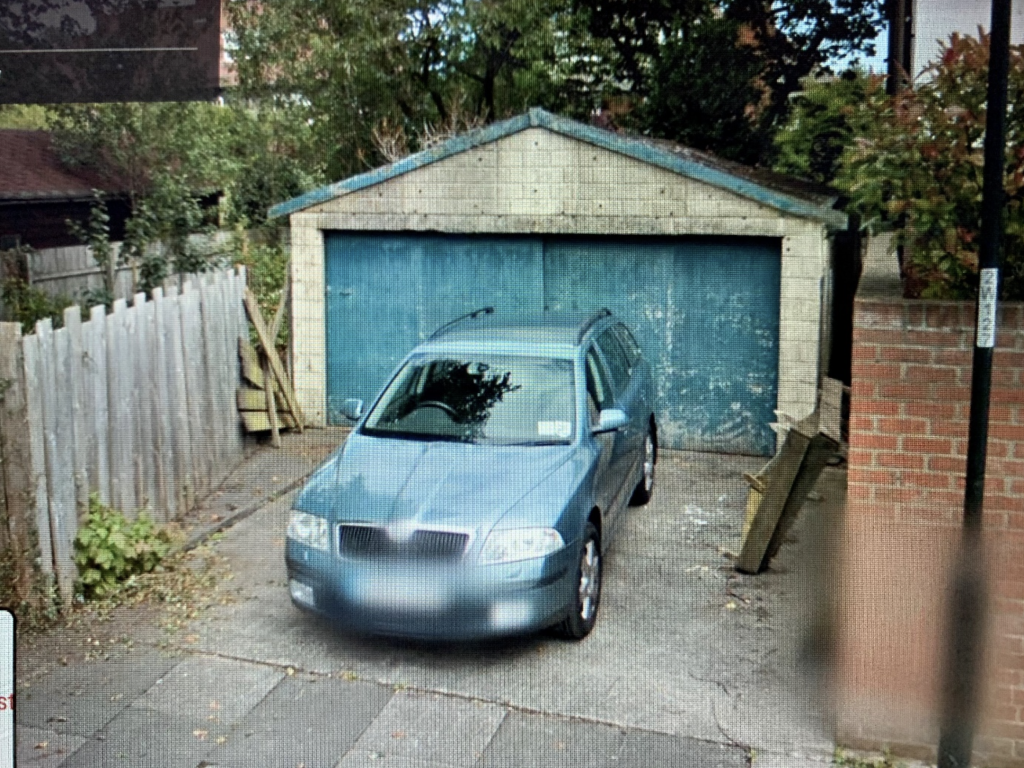
The tatty old garage on Westfield Grove that held the secret of the hidden Bugatti Atalante #57502. Note the faded remains of the Bugatti blue colour that solved the mystery. The high fence concealing the garage was actually hinged as a gate, seen in the open position here on the left. Harry was smart and had acquired the garage away from his home address to foil the treasure hunters and concealed the garage with the fence. Nothing of any interest here!
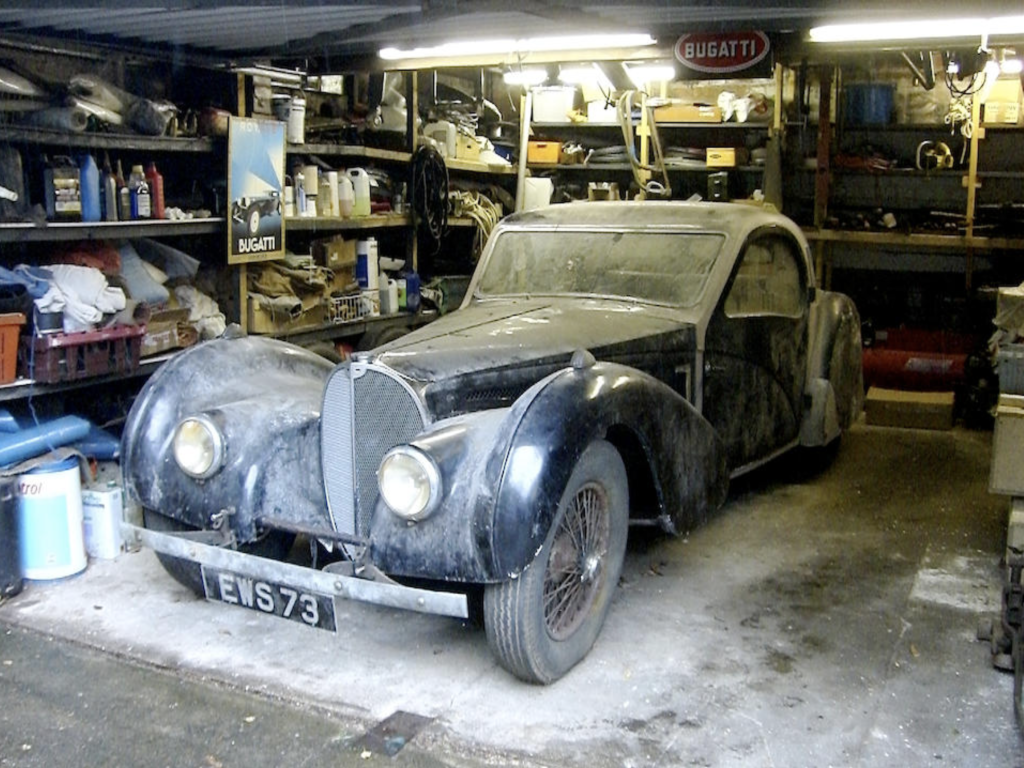
The garage door finally opened and the Atalante sees daylight for the first time since 1959. This was Harry’s treasure chest;honouring, organised, dryand safe. Notice the enamel badge is missing from the grill. There is no exterior badging depicting what make of car this is!
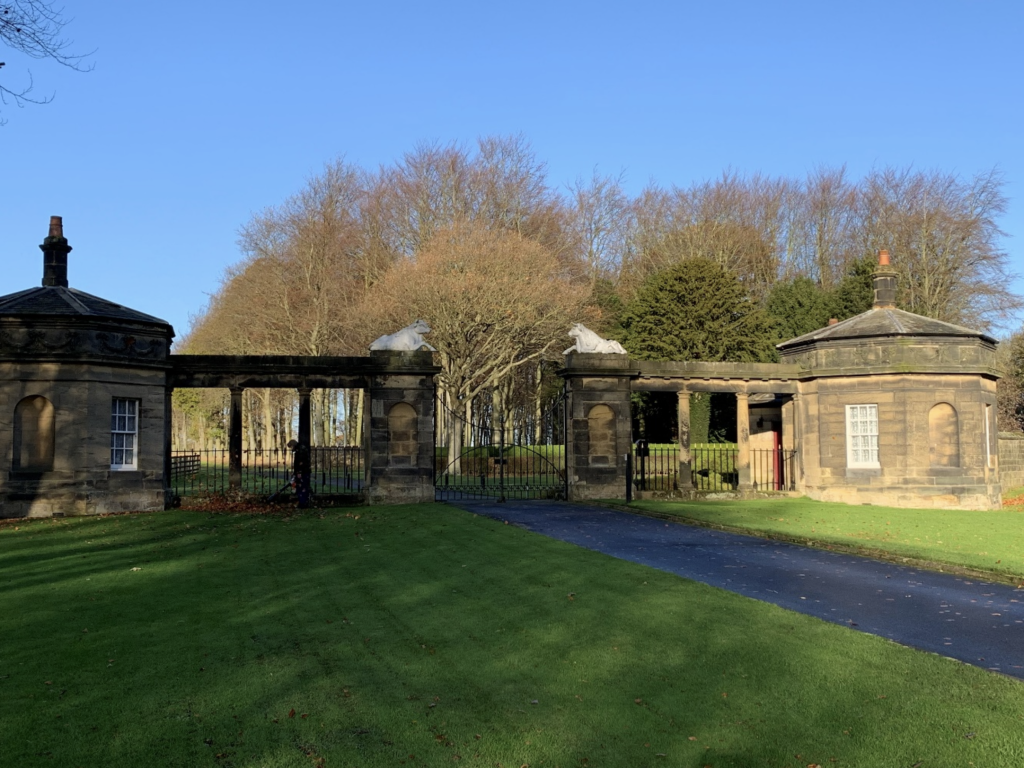
The wonderful South entrance to the Blagdon Hall Estate with imposing white bulls, not 3 miles from our family home in Blyth where I grew up. I would cycle past this on my childhood adventures unknowing that Atalante #57502 had regularly roared through these gates in the early 1950’s.
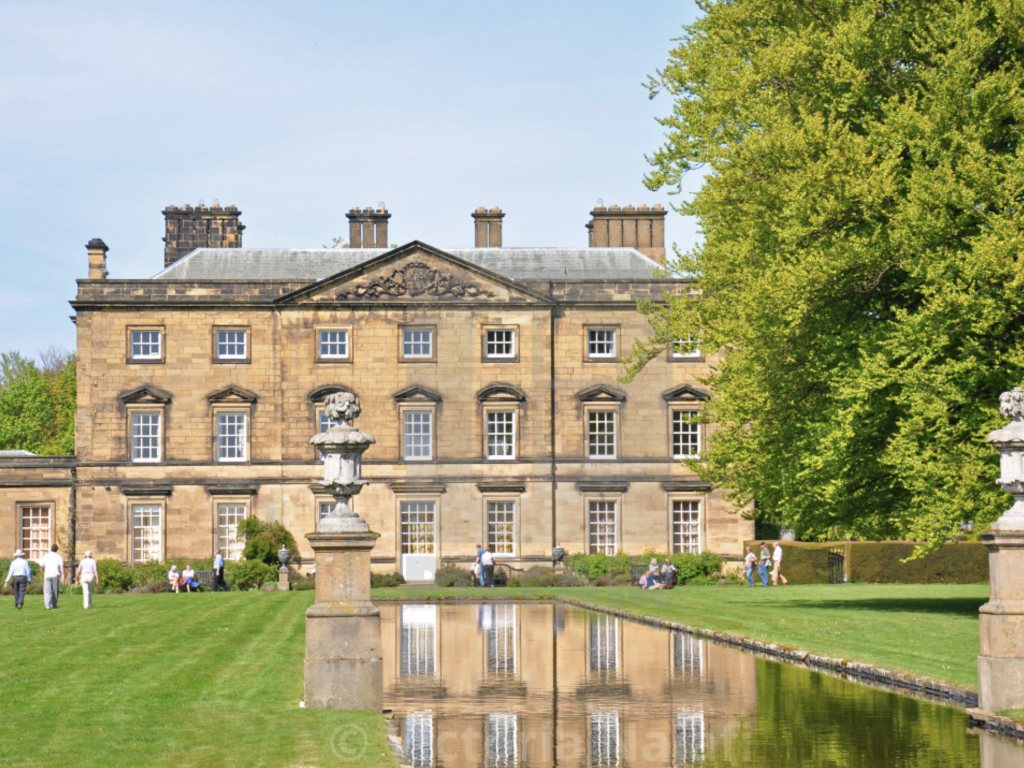
Blagdon Hall, Northumberland,Bugatti Atalante #57502 resided here in 1953

Harry’s receipt for the purchase of his dream car.
**The following photo’s are courtesy of Bonhams Auctioneers and show the Atalante cleaned and presented as a ‘true’ barn find. If ever a Bugatti deserved the time-warp label, this is it.
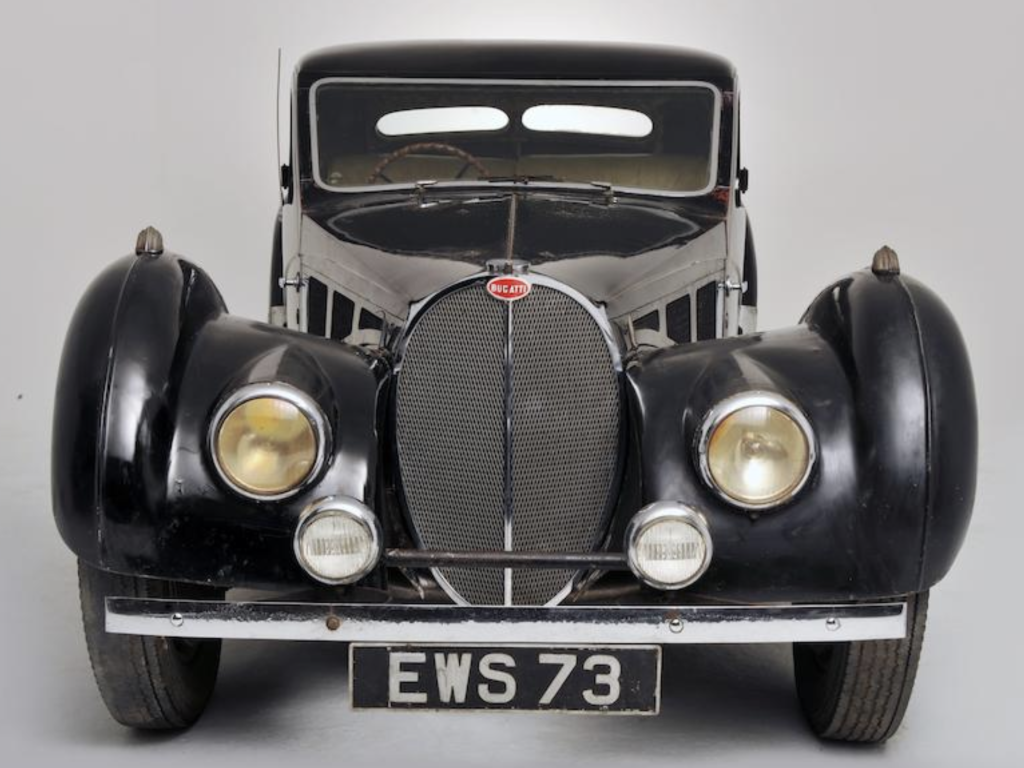

Just look at the stance, style and body-lines of the car. I think the rear ¾ angle is the real money-shot, just incredible.
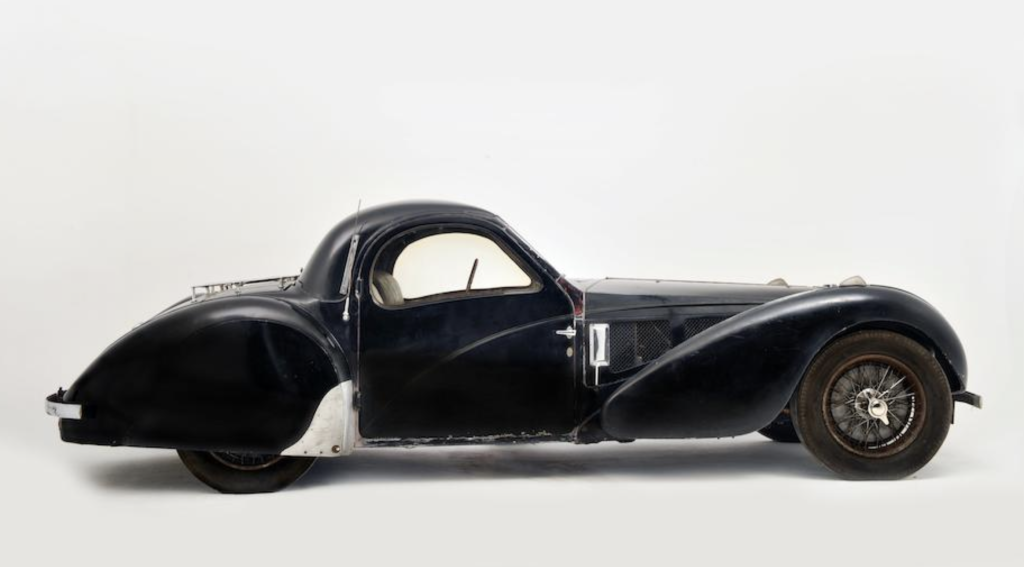
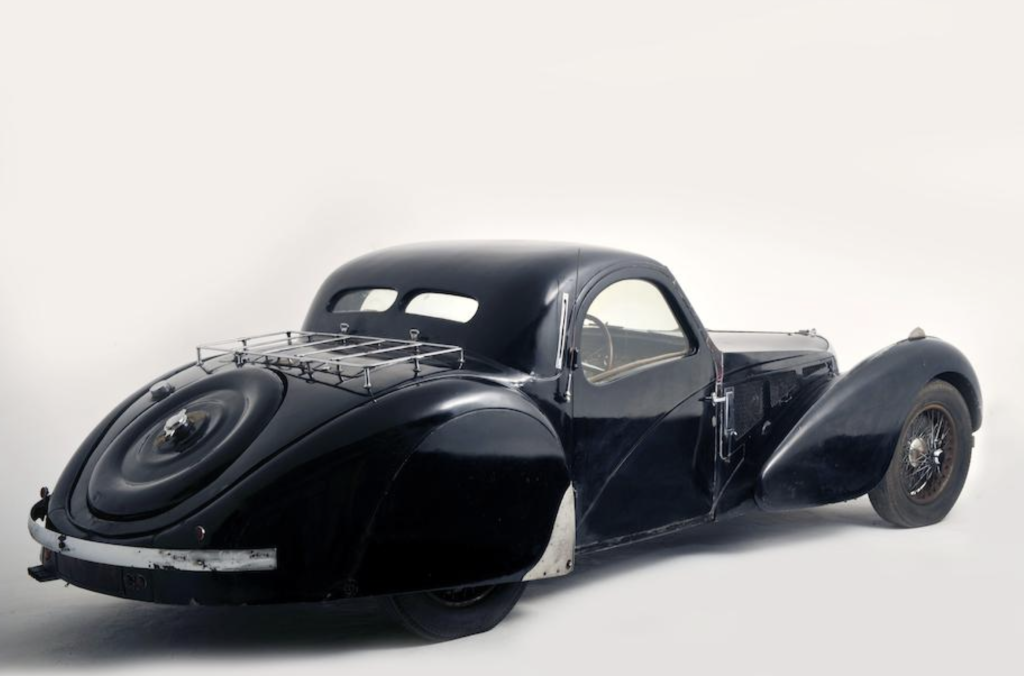
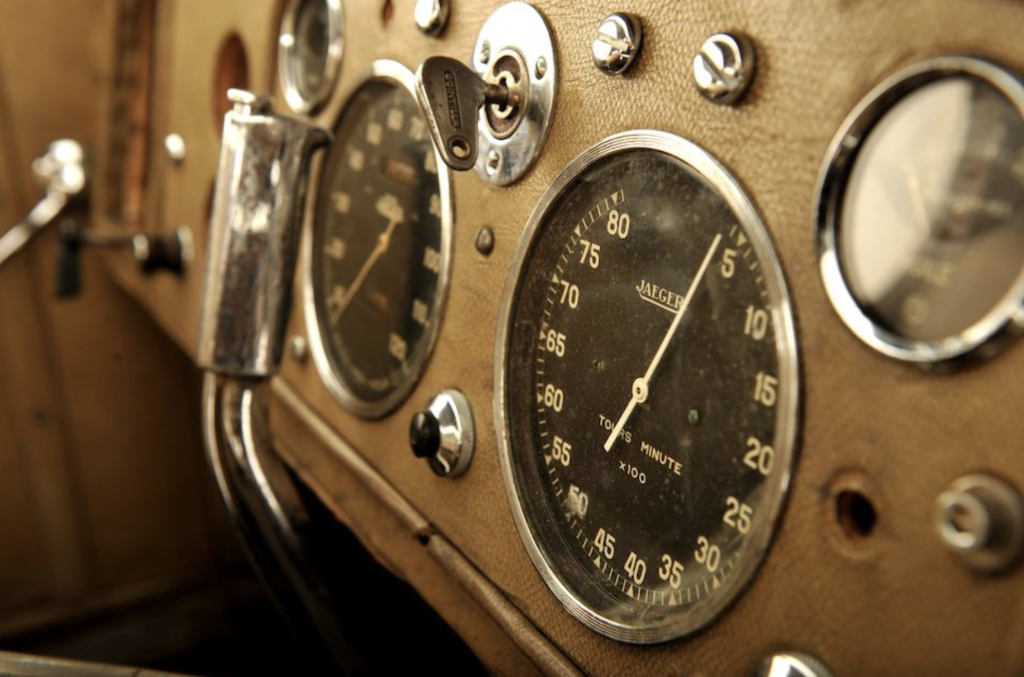
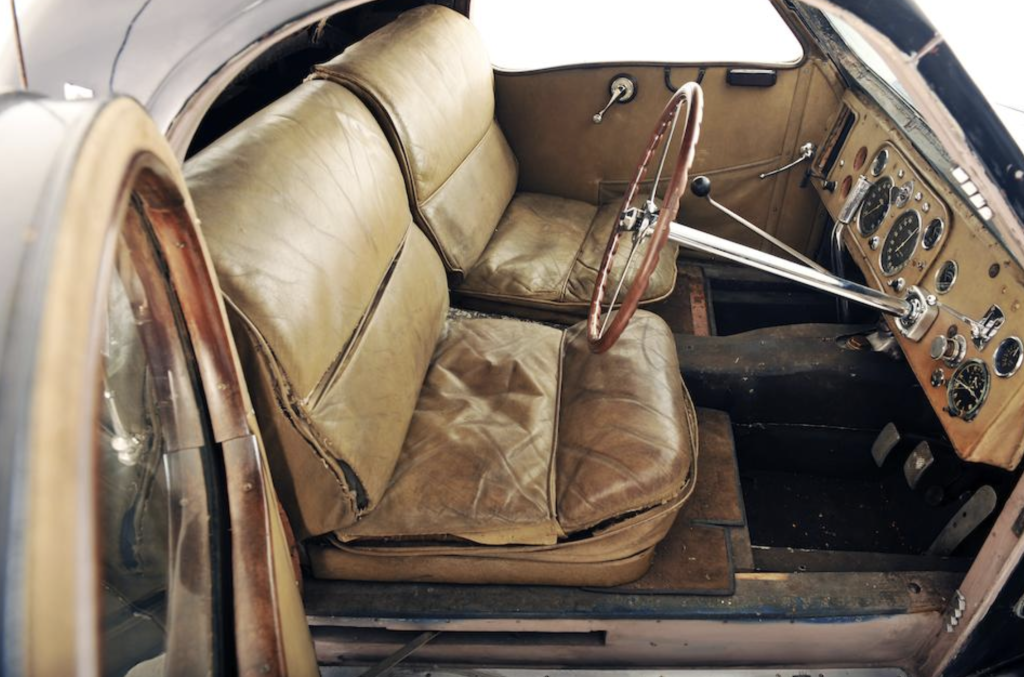
Now this is what I consider a spectacularly original 1930’s interior. Just as it was when I sat behind the wheel in 1987, only it has been delicately cleaned. This is real time-warp stuff. You can appreciate the ageing but just look closely at the quality of the materials and the craftsmanship of the build. Incredible.
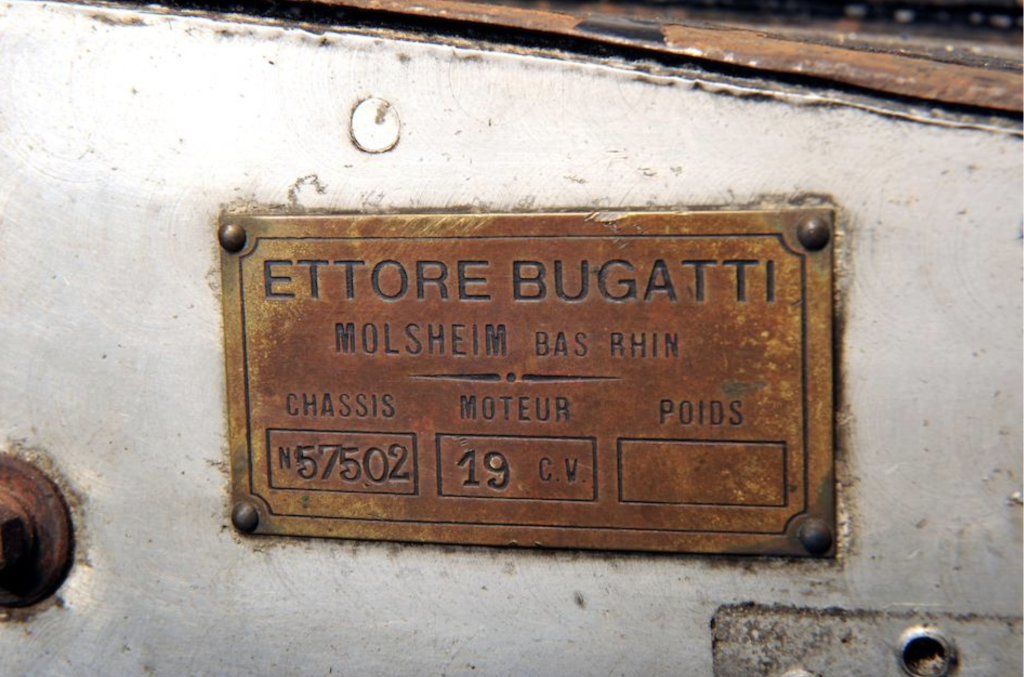

The overhead cam straight-eight in preserved but unrestored condition. What a wonderful sight to behold.
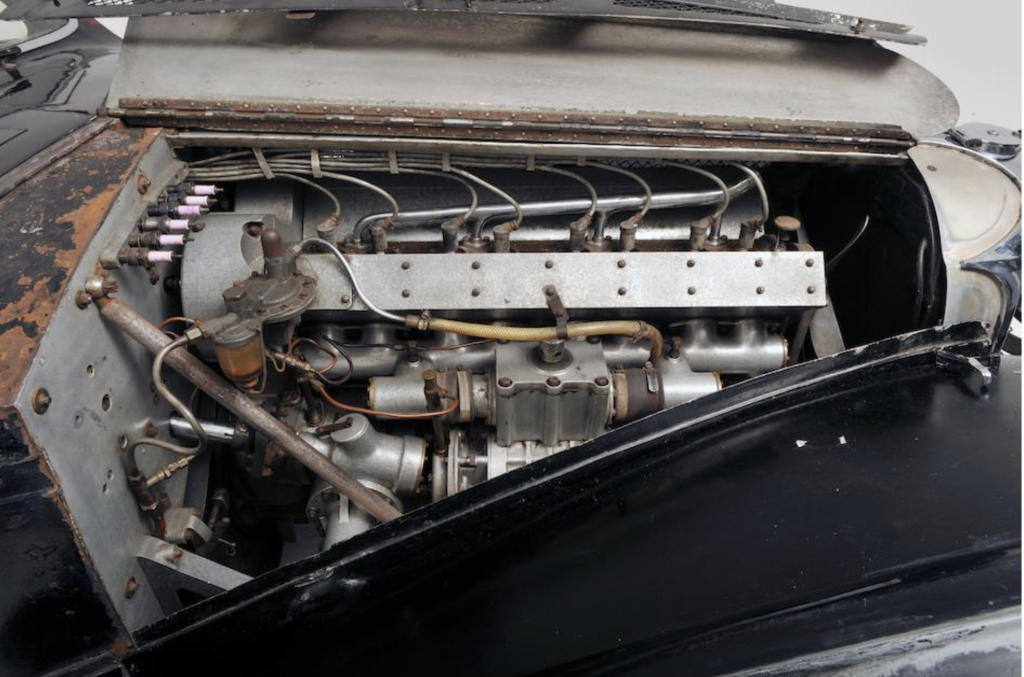
No later modifications other than the period Marshal super-charger which was added a few years post factory but was actually an option initially offered by the Molsheim factory. A spare set of spark plugs still evident as an essential for the long-distance motorist or avid amateur racer.

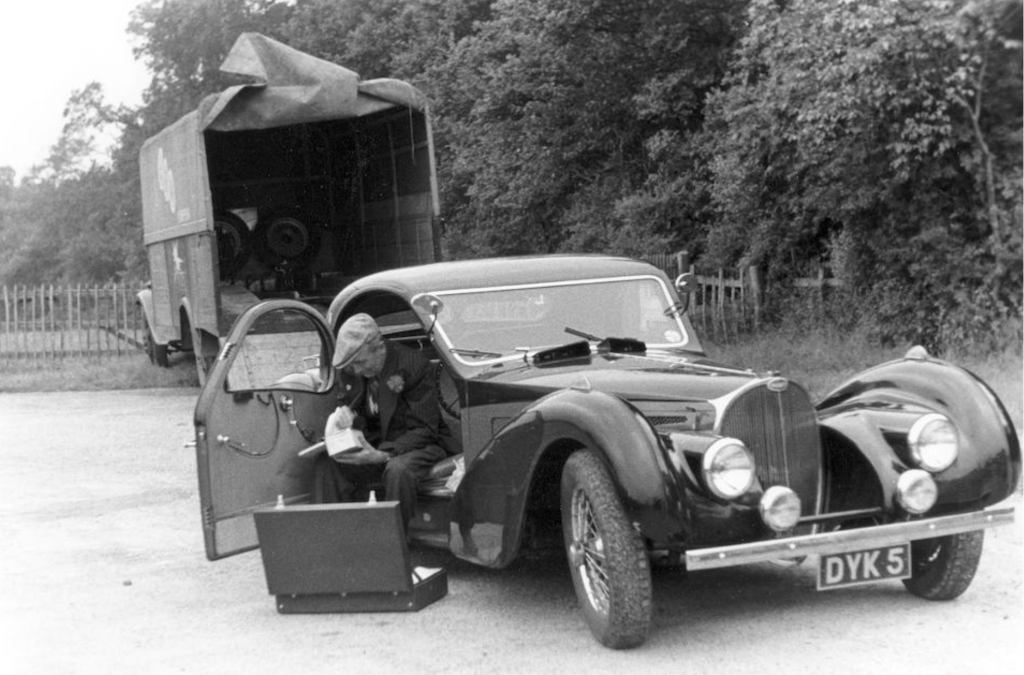
#57502 attending race meetings in Earl Howes ownership

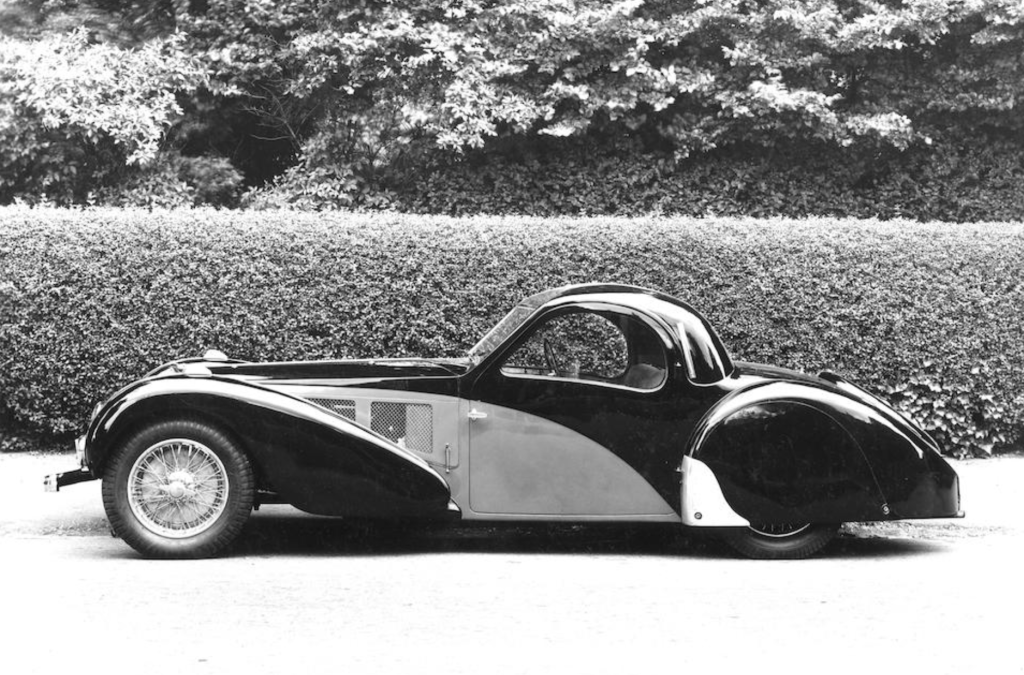
#57502 as it left the factory at Molsheim pre delivery to the UK. Note the directional Trafikators to the roof panel, two-tone livery (with light blue colour to the lower half as requested by Earl Howe) and lack of rear bumper. The front bumper featured was originally a two-piece scroll design.

